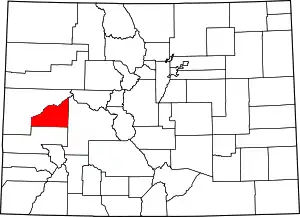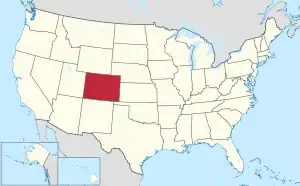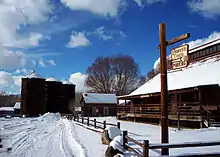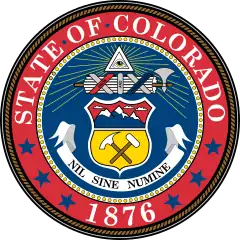Delta County, Colorado
Delta County is a county located in the U.S. state of Colorado. As of the 2010 census, the population was 30,952.[1] The county seat is Delta.[2]
Delta County | |
|---|---|
 | |
 Location within the U.S. state of Colorado | |
 Colorado's location within the U.S. | |
| Coordinates: 38°52′N 107°52′W | |
| Country | |
| State | |
| Founded | February 11, 1883 |
| Named for | City of Delta, Colorado |
| Seat | Delta |
| Largest city | Delta |
| Area | |
| • Total | 1,149 sq mi (2,980 km2) |
| • Land | 1,142 sq mi (2,960 km2) |
| • Water | 6.5 sq mi (17 km2) 0.6%% |
| Population | |
| • Estimate (2019) | 31,162 |
| • Density | 27/sq mi (10/km2) |
| Time zone | UTC−7 (Mountain) |
| • Summer (DST) | UTC−6 (MDT) |
| Congressional district | 3rd |
| Website | www |
.jpg.webp)

History
Delta County was created by the Colorado legislature on February 11, 1883, out of portions of central Gunnison County. The county was named from a delta of arable land at the mouth of the Uncompahgre River, where it flows into the Gunnison River.[3]
Geography
According to the U.S. Census Bureau, the county has a total area of 1,149 square miles (2,980 km2), of which 1,142 square miles (2,960 km2) is land and 6.5 square miles (17 km2) (0.6%) is water.[4]
Adjacent counties
- Mesa County – northwest
- Gunnison County – east
- Montrose County – south
Major Highways
 U.S. Highway 50
U.S. Highway 50 State Highway 65
State Highway 65 State Highway 92
State Highway 92 State Highway 133
State Highway 133 State Highway 348
State Highway 348
National protected areas
State protected areas
Trails and byways
- American Discovery Trail
- Crag Crest National Recreation Trail
- Old Spanish National Historic Trail
- Grand Mesa Scenic and Historic Byway
- West Elk Loop Scenic Byway
Demographics
| Historical population | |||
|---|---|---|---|
| Census | Pop. | %± | |
| 1890 | 2,534 | — | |
| 1900 | 5,487 | 116.5% | |
| 1910 | 13,688 | 149.5% | |
| 1920 | 13,668 | −0.1% | |
| 1930 | 14,204 | 3.9% | |
| 1940 | 16,470 | 16.0% | |
| 1950 | 17,365 | 5.4% | |
| 1960 | 15,602 | −10.2% | |
| 1970 | 15,286 | −2.0% | |
| 1980 | 21,225 | 38.9% | |
| 1990 | 20,980 | −1.2% | |
| 2000 | 27,834 | 32.7% | |
| 2010 | 30,952 | 11.2% | |
| 2019 (est.) | 31,162 | [5] | 0.7% |
| U.S. Decennial Census[6] 1790-1960[7] 1900-1990[8] 1990-2000[9] 2010-2015[1] | |||
At the 2000 census there were 27,834 people, 11,058 households, and 7,939 families living in the county. The population density was 24 people per square mile (9/km2). There were 12,374 housing units at an average density of 11 per square mile (4/km2). The racial makeup of the county was 92.29% White, 0.52% Black or African American, 0.76% Native American, 0.32% Asian, 0.03% Pacific Islander, 4.25% from other races, and 1.83% from two or more races. 11.39% of the population were Hispanic or Latino of any race.[10] Of the 11,058 households 29.00% had children under the age of 18 living with them, 60.30% were married couples living together, 7.90% had a female householder with no husband present, and 28.20% were non-families. 24.80% of households were one person and 12.40% were one person aged 65 or older. The average household size was 2.43 and the average family size was 2.89.
The age distribution was 24.00% under the age of 18, 6.30% from 18 to 24, 23.60% from 25 to 44, 26.50% from 45 to 64, and 19.70% 65 or older. The median age was 42 years. For every 100 females there were 100.80 males. For every 100 females age 18 and over, there were 98.60 males.
The median household income was $32,785 and the median family income was $37,748. Males had a median income of $31,348 versus $19,916 for females. The per capita income for the county was $17,152. About 8.50% of families and 12.10% of the population were below the poverty line, including 15.00% of those under age 18 and 9.60% of those age 65 or over.
Communities
City
Politics
Delta is a powerfully Republican county. No Democratic presidential candidate has reached forty percent of Delta County's vote since Lyndon Johnson carried the county in 1964, and since 1920 Franklin D. Roosevelt in 1932 is the only other Democrat to gain a majority, although Roosevelt did win a plurality against Alf Landon in 1936.
| Year | Republican | Democratic | Others |
|---|---|---|---|
| 2020 | 67.5% 13,081 | 30.4% 5,887 | 2.1% 402 |
| 2016 | 69.4% 11,655 | 24.3% 4,087 | 6.2% 1,048 |
| 2012 | 68.5% 10,915 | 29.0% 4,622 | 2.4% 388 |
| 2008 | 65.2% 10,067 | 32.9% 5,084 | 1.8% 283 |
| 2004 | 68.7% 9,722 | 29.8% 4,224 | 1.5% 213 |
| 2000 | 66.0% 8,372 | 25.7% 3,264 | 8.3% 1,050 |
| 1996 | 54.5% 6,047 | 32.3% 3,584 | 13.2% 1,469 |
| 1992 | 41.5% 4,359 | 32.6% 3,424 | 25.8% 2,711 |
| 1988 | 59.6% 5,449 | 38.5% 3,521 | 1.9% 174 |
| 1984 | 69.3% 6,678 | 29.4% 2,835 | 1.3% 126 |
| 1980 | 67.0% 6,179 | 25.5% 2,348 | 7.6% 700 |
| 1976 | 58.8% 4,980 | 38.2% 3,232 | 3.0% 255 |
| 1972 | 67.7% 4,890 | 26.4% 1,903 | 5.9% 427 |
| 1968 | 55.5% 3,692 | 35.0% 2,327 | 9.5% 633 |
| 1964 | 42.2% 2,883 | 57.5% 3,927 | 0.2% 16 |
| 1960 | 63.2% 4,644 | 36.6% 2,689 | 0.1% 10 |
| 1956 | 64.7% 4,531 | 35.1% 2,458 | 0.2% 13 |
| 1952 | 67.0% 4,986 | 32.1% 2,389 | 0.9% 66 |
| 1948 | 48.8% 3,158 | 49.0% 3,171 | 2.2% 140 |
| 1944 | 59.3% 3,462 | 40.3% 2,351 | 0.4% 25 |
| 1940 | 57.1% 4,175 | 41.6% 3,044 | 1.3% 96 |
| 1936 | 41.1% 2,661 | 49.9% 3,230 | 8.9% 577 |
| 1932 | 37.0% 2,341 | 54.8% 3,467 | 8.2% 519 |
| 1928 | 67.3% 3,731 | 30.2% 1,672 | 2.5% 139 |
| 1924 | 54.4% 2,752 | 26.6% 1,345 | 19.1% 966 |
| 1920 | 56.4% 2,596 | 38.0% 1,750 | 5.6% 257 |
| 1916 | 33.8% 1,612 | 59.0% 2,817 | 7.3% 348 |
| 1912 | 16.3% 803 | 36.7% 1,808 | 47.1% 2,320[lower-alpha 1] |
Media
The local papers are the Delta County Independent and the Merchant Herald.
See also
Notes
- The leading “other” candidate, Progressive Theodore Roosevelt, received 1,563 votes, while Socialist candidate Eugene Debs received 560 votes, Prohibition candidate Eugene Chafin received 194 votes, and Socialist Labor candidate Arthur Reimer received 3 votes.
References
- "State & County QuickFacts". United States Census Bureau. Archived from the original on June 6, 2011. Retrieved January 25, 2014.
- "Find a County". National Association of Counties. Archived from the original on 2011-05-31. Retrieved 2011-06-07.
- Gannett, Henry (1905). The Origin of Certain Place Names in the United States. Govt. Print. Off. pp. 103.
- "US Gazetteer files: 2010, 2000, and 1990". United States Census Bureau. 2011-02-12. Retrieved 2011-04-23.
- "Population and Housing Unit Estimates". Retrieved December 3, 2019.
- "U.S. Decennial Census". United States Census Bureau. Retrieved June 7, 2014.
- "Historical Census Browser". University of Virginia Library. Retrieved June 7, 2014.
- "Population of Counties by Decennial Census: 1900 to 1990". United States Census Bureau. Retrieved June 7, 2014.
- "Census 2000 PHC-T-4. Ranking Tables for Counties: 1990 and 2000" (PDF). United States Census Bureau. Retrieved June 7, 2014.
- "U.S. Census website". United States Census Bureau. Retrieved 2011-05-14.
- Leip, David. "Dave Leip's Atlas of U.S. Presidential Elections". uselectionatlas.org. Retrieved May 26, 2017.
External links
- Delta County Government website
- Colorado County Evolution by Don Stanwyck
- Colorado Historical Society
- Delta Real Time Weather
| Wikimedia Commons has media related to Delta County, Colorado. |
